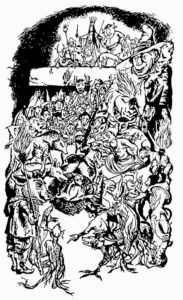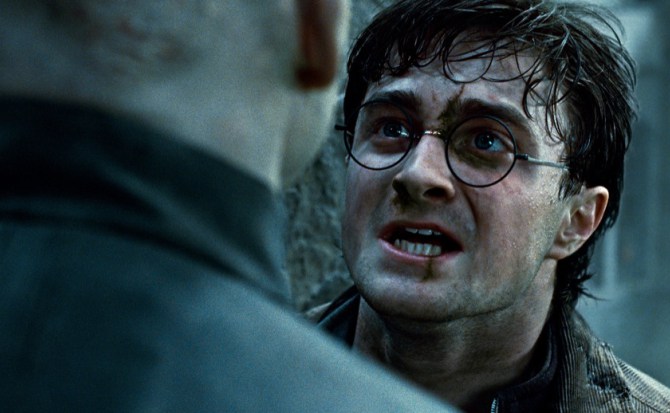Spiritual Sunday
Having just taught Harry Potter and the Deathly Hallows in my British Fantasy class, I am more puzzled than ever by Christian parents who forbid their children to read the book. Rowling all but bludgeons readers with the theme that love conquers death. Consider rereading Deathly Hallows as a prelude to Holy Week.
I know that parents have banned Harry Potter because multiple students have reported their experiences to me. Interestingly, many of them were encouraged to read C. S. Lewis’s Narnia series, which is ironic given that Rowling borrows Harry’s death scene directly from Aslan’s crucifixion in The Lion, the Witch, and the Wardrobe.
In Lewis’s novel, Christ-figure Aslan chooses to sacrifice himself, shouldering Edmund’s sin in order to cleanse the world. In a dramatic scene, captured memorably by illustrator Pauline Baynes, he gives himself up to the White Witch and her followers:
A great crowd of people were standing all round the Stone Table and though the moon was shining many of them carried torches which burned with evil-looking red flames and black smoke. But such people! Ogres with monstrous teeth, and  wolves, and bull-headed men; spirits of evil trees and poisonous plants; and other creatures whom I won’t describe because if I did the grown-ups would probably not let you read this book — Cruels and Hags and Incubuses, Wraiths, Horrors, Efreets, Sprites, Orknies, Wooses, and Ettins. In fact here were all those who were on the Witch’s side and whom the Wolf had summoned at her command. And right in the middle, standing by the Table, was the Witch herself.
wolves, and bull-headed men; spirits of evil trees and poisonous plants; and other creatures whom I won’t describe because if I did the grown-ups would probably not let you read this book — Cruels and Hags and Incubuses, Wraiths, Horrors, Efreets, Sprites, Orknies, Wooses, and Ettins. In fact here were all those who were on the Witch’s side and whom the Wolf had summoned at her command. And right in the middle, standing by the Table, was the Witch herself.
A howl and a gibber of dismay went up from the creatures when they first saw the great Lion pacing towards them, and for a moment even the Witch seemed to be struck with fear. Then she recovered herself and gave a wild fierce laugh.
“The fool!” she cried. “The fool has come. Bind him fast.”
Here’s the echoing scene in Deathly Hallows:
A fire burned in the middle of the clearing, and its flickering light fell over a crowd of completely silent, watchful Death Eaters. Some of them were still masked and hooded, others showed their faces. Two giants sat on the outskirts of the group, casting massive shadows over the scene, their faces cruel, rough-hewn like rock. Harry saw Fenrir, skulking, chewing his long nails; the great, blond Rowle was dabbing at his bleeding lip. He saw Lucius Malfoy, who looked defeated and terrified, and Narcissa, whose eyes were sunken and full of apprehension.
Every eye was fixed upon Voldemort, who stood with his head bowed, and his white hands folded over the Elder Wand in front of him. He might have been praying, or else counting silently in his mind, and Harry, standing still on the edge of the scene, thought absurdly of a child counting in a game of hide-and-seek. Behind his head, still swirling and coiling, the great snake Nagini floated in her glittering, charmed cage, like a monstrous halo.
Rowling signals her Christian message early on through the epitaph on the tombstone of Harry ‘s parents, which Harry visits when seeking to understand his mission:
The last enemy that shall be destroyed is death.
Harry then undergoes a version of Jesus’s temptations in the desert. Although his spiritual guide Dumbledore has instructed him to destroy the horcruxes in which Voldemort has deposited his soul (thereby rendering himself immortal), Harry has doubts and thinks it might be better to opt for earthly power to defeat him. Voldemort means “flight from death,” and the dark wizard thinks that reassembling the three “deathly hallows”—especially the all-powerful Elder Wand—will save him. When Harry wants the wand for himself, he is thinking of death in Voldemort’s terms.
The deathly hallows appear in a story of three brothers who set out to defy death. The first two demand totems that will preserve them, the wand and a “resurrection stone” that can bring people back from the dead. Although Death presents them with these items, the brothers still die early. The third brother asks for an invisibility cloak that allows him to evade death’s notice, which he does until he has lived to a ripe old age.
The deathly hallows don’t match up exactly with Satan’s temptations, but the wand is a version of Satan’s offer of earthly power and the stone is like Satan’s promise of Jesus miraculously defying death. (Regarding Satan’s other temptation of turning stones into bread, it’s noteworthy that the food conjured up by magic in Potter World cannot sustain life.) Like Jesus, who abandons earthly power (thereby displeasing Peter), Harry opts for what Aslan calls “deeper magic from before the dawn of time.” He articulates the choice as “horcruxes, not hallows.”
Like Jesus, Harry also has a Garden of Gethsemane moment of doubt as he walks towards his death in the Forbidden Forest. Because Harry knows his end is near, life appears especially precious:
Slowly, very slowly, he sat up and as he did so he felt more alive and more aware of his own living body than ever before. Why had he never appreciated what a miracle he was, brain and nerve and bounding heart? It would all be gone… or at least, he would be gone from it.
Nevertheless, he now understands what is called for and essentially decides, “Thy will be done”:
Of course there had been a bigger plan; Harry had simply been too foolish to see it, he realized that now. He had never questioned his own assumption that Dumbledore wanted him alive. Now he saw that his life span had always been determined by how long it took to eliminate all the Horcruxes.
In other words, he must save humankind, who in their fear of death violate their souls.
I should mention here the resurrection stone that Harry carries. It has been hidden in an object that, until this moment, Harry cannot open. With his expanding awareness, however, he has a glimpse of true resurrection, and the opening spell anticipates Jesus’s empty tomb: “I open at the close.” Although previous owners have interpreted the stone through their fears—bringing people back from the dead is a literal way to overcome death—Harry uses it in a healthy way: he touches base with those who have loved him and who give him the strength to carry on. True resurrection is love, which can never die:
“You’ll stay with me?”
“Until the very end,” said James.
“They won’t be able to see you?” asked Harry.
“We are part of you,” said Sirius. “Invisible to anyone else.”
Harry looked at his mother.
“Stay close to me,” he said quietly.
I would not want to bring my oldest son, who died at 21, back from the dead. My love for him is eternal. That’s what Jesus means by heaven on earth.
Harry also undergoes a version of Jesus’s descent into death, noted in the Nicene Creed. There he encounters Dumbledore, who affirms his choices. In this shadow world we see Voldemort’s inner suffering, represented by a miserable “flayed” baby. When we sell our souls and commit atrocities in order to “flee from death,” we condemn ourselves to perpetual unhappiness. Dumbledore has such misery in mind when he says,
“Do not pity the dead, Harry. Pity the living, and, above all, those who live without love. By returning, you may ensure that fewer souls are maimed, fewer families are torn apart. If that seems to you a worthy goal, then we say good-bye for the present.”
Harry nodded and sighed. Leaving this place would not be nearly as hard as walking into the forest had been, but it was warm and light and peaceful here, and he knew that he was heading back to pain and fear of more loss.
In his final encounter with Voldemort, Harry remembers the suffering baby, calls Voldemort by his human name (Tom Riddle), and gives him a chance to repent. This is the crucified Jesus pitying those whose suffering causes them to be cruel: “Father, forgive them, for they know not what they do.” Harry says,
“[B]efore you try to kill me, I’d advise you to think about what you’ve done .. think, and try for some remorse, Riddle …”
“What is this?”
Of all the things that Harry had said to him, beyond any revelation or taunt, nothing had shocked Voldemort like this.
Harry saw his pupils contract to thin slits, saw the skin around his eyes whiten.
“It’s your one last chance,” said Harry, “it’s all you’ve got left … I’ve seen what you’ll be otherwise … be a man … try … try for some remorse…”
Voldemort, however, cannot hear the appeal—which is to say, he cannot step beyond his angry suffering:
“Is it love again?” said Voldemort, his snake’s face jeering. “Dumbledore’s favorite solution, love, which he claimed conquered death, though love did not stop him falling from the tower and breaking like an old waxwork? Love, which did not prevent me from stamping out your Mudblood mother like a cockroach, Potter – and nobody seems to love you enough to run forward this time and take my curse. So what will stop you from dying now when I strike?”
Death dies as Voldemort’s killing curse rebounds upon himself. Harry’s compassion and love triumph o’er the grave.
We live in a world where fear talks big and seems to have love on the run. Yet millions marched yesterday against the fear that fuel gun purchases–teachers prefer Harry’s disarmament spell (“Expelliarmus!”) to Voldemort’s imperius curse–and millions are resisting Donald Trump’s bellicosity, even as he names war monger John Bolton to be national security advisor. While love in the face of fear has always been a tough sell (as Jesus well knew), we return to it time after time.
To cite Michelle Obama, when Voldemort goes low, Harry goes high.


